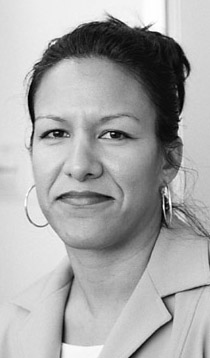|
DAs and Social Workers Team Up
by Richard Bermack September 2002 Dependency court and children's protective services are often a tangled web of conflicting interests. You have county counsel representing the department of family and children services, you have a lawyer representing the parents, and a third lawyer is supposed to represent the child. In the best situations the child's natural parents can be given services to make their home a safe place where the child can thrive. But unfortunately that is not always the case, and it usually is not that simple. And the issues are much more complex than whether the child should be removed from the parents. Intervention is an opportunity for a social worker to evaluate not only what it will take to make the home safe and what services to provide the parents, but also what services each individual child in the home needs. In a home with four children and two adults, there are a lot of people for one worker to evaluate and provide services to. And it doesn't stop there. Besides the parents and children, the social worker has two other important parties to satisfy: the department of social services and the courts, each with their own needs and guidelines. Not surprisingly, critics question whether the children's interests are being lost in the process. In response, regulations now require that children have their own legal representation, separate from the parents and separate from the county. In Santa Clara County an office of private attorneys represents the parents, county counsel represents the department, and the district attorney represents the child. Deputy District Attorney Penelope Blake is a supervisor for the DAs representing children in Santa Clara County. She realized that it was not enough to have a separate attorney for the child. She recognized the need to have access to a clinical assessment of the case. To do an effective job, Blake concluded, the DAs needed their own social workers to evaluate the children, social workers not beholden to the department.
If you question whether DAs, who ordinarily prosecute people, describing them in their worst light so they can be sent to jail, would work well with people whose mission is to bring out the best in people, you are not alone. When Blake first suggested that the DAs should get their own social workers, who would work with them as a team, some of the other DAs referred to the attempt as “Penny's follies.” But Blake saw something the others were missing. Before getting her law degree, Blake had received a masters in psychology. She understood the value of having someone the DAs could call their own, trained in social work and psychological issues. She studied the literature and came up with a program in which both groups would work as equals, complementing each other's professional skills. That way, both groups could act with integrity, with the social workers providing social work expertise and the attorneys the legal strategy, with no attempts to second guess each other, all for the best interest of the child. Before Blake could launch the program, she had to sell it to the Santa Clara Board of Supervisors. It was during a budget crunch, so she suggested that they create one licensed clinical social worker position for the DAs office and use interns to do some of the work. She sold it as a cost-saving measure. The program was perfect for interns, who would get valuable training in the legal issues and how cases are presented to a court. One of the most common complaints from new children's services workers is that they are not properly trained or prepared for court procedures. Graduating students with MSWs could also use the internships to satisfy Title IV(e) requirements, under which they receive a stipend for a two-year commitment to work at a county child welfare agency after obtaining their MSW. Blake picked her social worker and attorneys well. She hired Michael Gammino, an experienced social worker from San Francisco. She gets a three-year commitment to the assignment from the attorneys and with Gammino, trains them in early childhood development and other issues particular to dependency court. While in this unit, they do only dependency work. “No question they are making different types of decisions representing
kids versus prosecuting. They become very good at negotiating and mediating. We try to use mediation and family conferencing as much as possible,” Blake explains. “Their only regrets are that sometimes they feel like their trial skills are getting a little rusty, working here, although we do get some long complicated trials.” One of the tricky aspects of this work is knowing what the child wants, but not pressing for a placement that is unsafe. “Safety is our focus,” Blake notes. “And if a client is badly injured, we can call over to the criminal side and encourage them to prosecute. However, we cannot give them information out of the dependency records, which we keep separate to protect the clients' privilege.” She knew the program was a success when the same attorneys who used to tease her would frequently call up to ask for social worker Gammino's help to evaluate a case. “I think that Michael won them over, and they use his services the most,” she confides. The collaboration is not just one sided, or restricted to the court arena. Nor is it adversarial. “Most of the time we are in agreement with the department,” Blake states. In many ways she sees the social worker's role as supplementing the reports of over-worked and over-extended DFCS staff. Her social workers evaluate the services the child needs, such as health, mental health, and special education, and then make sure they get them. “We do a lot of IEPs,” Blake states. Many children that come into the foster care system have learning disabilities and other issues requiring Individual Education Plans. Social workers often find themselves battling school administrators to force them to spend the extra money for services on a client. Having a DA explain to a principal the school's responsibilities under the law can be very helpful. How effective is the program in representing the interests of children? Blake proudly states that one measure of the success is that her kids in the dependency system enter the delinquency system at no greater rate than kids in the general population. This is no minor accomplishment, when you consider that the same issues that push kids into the foster system are those that cause kids to be at risk of entering the delinquency system.
|
|||||||||||||



